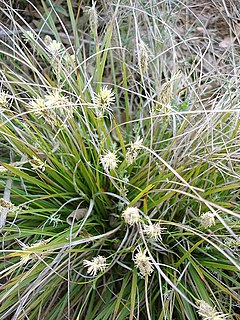
The Cyperaceae are a family of graminoid (grass-like), monocotyledonous flowering plants known as sedges. The family is large, with some 5,500 known species described in about 90 genera, the largest being the "true sedges" genus Carex with over 2,000 species.

Pinctada is a genus of saltwater oysters, marine bivalve mollusks in the family Pteriidae. These pearl oysters have a strong inner shell layer composed of nacre, also known as "mother of pearl".

Ornamental grasses are grasses grown as ornamental plants. Ornamental grasses are popular in many colder hardiness zones for their resilience to cold temperatures and aesthetic value throughout fall and winter seasons.

Carex is a vast genus of more than 2,000 species of grass-like plants in the family Cyperaceae, commonly known as sedges. Other members of the family Cyperaceae are also called sedges, however those of genus Carex may be called true sedges, and it is the most species-rich genus in the family. The study of Carex is known as caricology.

The chestnut-eared bunting, also called grey-headed bunting or grey-hooded bunting, with the latter name also used for grey-necked bunting, is a passerine bird in the bunting family Emberizidae.

Gari is a genus of bivalve molluscs in the family Psammobiidae, known as sunset shells.

The tawny-headed swallow is a species of bird in the family Hirundinidae. It is monotypic within the genus Alopochelidon. It is found in Argentina, Bolivia, Brazil, Colombia, Falkland Islands, Paraguay, Peru, Uruguay, and Venezuela, where its natural habitats are dry savanna and subtropical or tropical seasonally wet or flooded lowland grassland.

Plesanemma fucata, the lemon gum moth, is a moth of the family Geometridae. The species was first described by Rudolf Felder and Alois Friedrich Rogenhofer in 1875. It is found in the southern half of Australia.

Fenimorea fucata is a species of sea snail, a marine gastropod mollusc in the family Drilliidae.

Hypselodoris fucata is a species of sea slug or dorid nudibranch, a marine gastropod mollusk in the family Chromodorididae.

Carex riparia, the greater pond sedge, is a species of sedge found across Europe and Asia. It grows in a variety of wet habitats, and can be a dominant species in some swamps. It is Britain's largest Carex, growing up to 130 cm tall, with glaucous leaves up to 160 cm long. It hybridises with a number of other Carex species, including the closely related Carex acutiformis – the lesser pond sedge. A variegated cultivar is grown as an ornamental grass.

Carex hirta, the hairy sedge or hammer sedge, is a species of sedge native across Europe. It has characteristic hairy leaves and inflorescences, and is the type species of the genus Carex.

Carex subg. Carex is a subgenus of the sedge genus Carex. It is the largest of the four traditionally recognised subgenera, containing around 1400 of the 2000 species in the genus. Its members are characterised by the presence of one or more exclusively male (staminate) terminal spikes, quite dissimilar in appearance from the lateral female (pistillate) spikes below. In most species, the female flowers have three stigmas, but a few species, including Carex nigra, have female flowers with only two stigmas.
Pinctada fucata, the Akoya pearl oyster (阿古屋貝), is a species of marine bivalve mollusc in the family Pteriidae, the pearl oysters. Some authorities classify this oyster as Pinctada imbricata fucata. It is native to shallow waters in the Indo-Pacific region and is used in the culture of pearls.

Carex subg. Vignea is a subgenus of the sedge genus Carex, containing around 300 of the 2000 species in the genus. Its members are characterised by having bisexual, sessile spikes, where the female flowers have two stigmas each.

Taeniamia fucata, commonly known as the orange-lined- or painted cardinalfish, is a marine fish native to reefs from northern Australia and New Guinea, across the Indian Ocean to the east coast of Africa, and Pacific Ocean to Marshall Islands, Samoa, Tonga, and the Ryukyu Islands. It was known as Archamia fucata until 2013. FishBase treats T. sansibaricus as synonymous with T. fucata. but T. sansibaricus is recognised as valid by the Catalog of Fishes:
Thereva fucata is a species of stiletto-flies in the family Therevidae.

Neanthes fucata is a species of marine polychaete worm in the family Nereididae. It lives in association with a hermit crab such as Pagurus bernhardus. It occurs in the northeastern Atlantic Ocean, the North Sea and the Mediterranean Sea.














